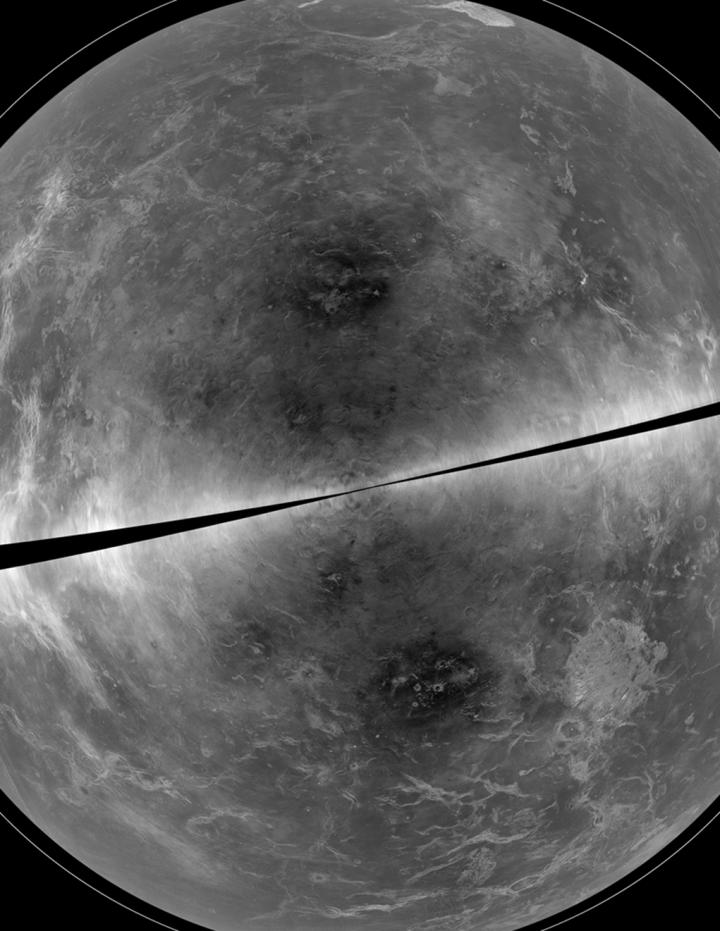Venus, if you will, as seen in radar with the GBT

This is a projection of the radar data of Venus collected in 2012. Striking surface features -- like mountains and ridges -- are easily seen. The black diagonal band at the center represents areas too close to the Doppler 'equator' to obtain well-resolved image data. Credit: B. Campbell et al., NRAO/AUI/NSF, Arecibo
Recently, by combining the highly sensitive receiving capabilities of the National Science Foundation's (NSF) Green Bank Telescope (GBT) and the powerful radar transmitter at the NSF's Arecibo Observatory, astronomers were able to make remarkably detailed images of the surface of this planet without ever leaving Earth.
The radar signals from Arecibo passed through both our planet's atmosphere and the atmosphere of Venus, where they hit the surface and bounced back to be received by the GBT in a process known as bistatic radar.
This capability is essential to study not only the surface as it appears now, but also to monitor it for changes. By comparing images taken at different periods in time, scientists hope to eventually detect signs of active volcanism or other dynamic geologic processes that could reveal clues to Venus's geologic history and subsurface conditions.
High-resolution radar images of Venus were first obtained by Arecibo in 1988 and most recently by Arecibo/GBT in 2012, with additional coverage in the early 2000s by Lynn Carter of NASA's Goddard Spaceflight Center in Greenbelt, Md. The first of those observations was an early science commissioning experiment for the GBT.
“It is painstaking to compare radar images to search for evidence of change, but the work is ongoing. In the meantime, combining images from this and an earlier observing period is yielding a wealth of insight about other processes that alter the surface of Venus,” said Bruce Campbell, Senior Scientist with the Center for Earth and Planetary Studies at the Smithsonian's National Air and Space Museum in Washington, D.C. A paper discussing the comparison between these two observations was accepted for publication in the journal Icarus.
The 100-meter Green Bank Telescope is the world's largest fully steerable radio telescope. Its location in the National Radio Quiet Zone and the West Virginia Radio Astronomy Zone protects the incredibly sensitive telescope from unwanted radio interference, enabling it to perform unique observations.
Media Contact
All latest news from the category: Physics and Astronomy
This area deals with the fundamental laws and building blocks of nature and how they interact, the properties and the behavior of matter, and research into space and time and their structures.
innovations-report provides in-depth reports and articles on subjects such as astrophysics, laser technologies, nuclear, quantum, particle and solid-state physics, nanotechnologies, planetary research and findings (Mars, Venus) and developments related to the Hubble Telescope.
Newest articles

Properties of new materials for microchips
… can now be measured well. Reseachers of Delft University of Technology demonstrated measuring performance properties of ultrathin silicon membranes. Making ever smaller and more powerful chips requires new ultrathin…

Floating solar’s potential
… to support sustainable development by addressing climate, water, and energy goals holistically. A new study published this week in Nature Energy raises the potential for floating solar photovoltaics (FPV)…

Skyrmions move at record speeds
… a step towards the computing of the future. An international research team led by scientists from the CNRS1 has discovered that the magnetic nanobubbles2 known as skyrmions can be…





















